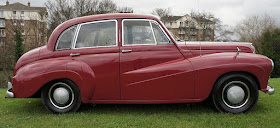Lanchester's Fourteen model first appeared in 1936. Its postwar redesign was announced October 1950, production continuing into 1953 when the car was essentially rebadged as the Daimler Conquest that continued to 1958.
Postwar Fourteens had "coachbuilt" bodies in the sense that framing was wood. An all-metal version for export was called the Leda. This puzzled me, but then this was England after all, and the English can be whimsical. Or, much more likely, postwar shortages and production restrictions had something to do with this.
Lanchester Fourteen from around 1951. Styling is in the same spirit as some other early postwar English cars. Grilles were vertical and front fenders flowed over front doors. The cars tended to be rather tall and narrow, but this suited English driving conditions in pre-Motorway days.
Side view of a Fourteen up for auction. It can be considered a six-window saloon, all passengers having good views of the car's surroundings. Note the turn indicator wand on the B-pillar.
Same car. The large boot (trunk) is practical, but removes whatever grace the design otherwise might have. The fold at door handle level helps the break up any slab-sidedness and helps tie the front and rear together. The character lines on the fenders also break up surfaces, but are a bit fussy and their elimination would have improved the design.
Leda version of the Fourteen in a for-sale photo.
Daimler Conquest. The main difference from the Fourteen is the traditional Daimler grille with its ribbed upper frame.





No comments:
Post a Comment